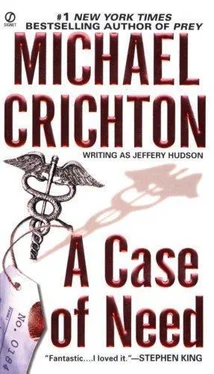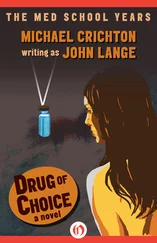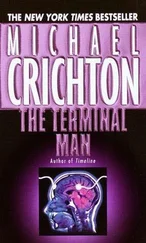Michael Crichton - A Case of Need
Здесь есть возможность читать онлайн «Michael Crichton - A Case of Need» весь текст электронной книги совершенно бесплатно (целиком полную версию без сокращений). В некоторых случаях можно слушать аудио, скачать через торрент в формате fb2 и присутствует краткое содержание. Город: New York, Год выпуска: 2003, ISBN: 2003, Издательство: Signet, Жанр: thriller_medical, на английском языке. Описание произведения, (предисловие) а так же отзывы посетителей доступны на портале библиотеки ЛибКат.
- Название:A Case of Need
- Автор:
- Издательство:Signet
- Жанр:
- Год:2003
- Город:New York
- ISBN:9780451210630
- Рейтинг книги:5 / 5. Голосов: 1
-
Избранное:Добавить в избранное
- Отзывы:
-
Ваша оценка:
- 100
- 1
- 2
- 3
- 4
- 5
A Case of Need: краткое содержание, описание и аннотация
Предлагаем к чтению аннотацию, описание, краткое содержание или предисловие (зависит от того, что написал сам автор книги «A Case of Need»). Если вы не нашли необходимую информацию о книге — напишите в комментариях, мы постараемся отыскать её.
A Case of Need — читать онлайн бесплатно полную книгу (весь текст) целиком
Ниже представлен текст книги, разбитый по страницам. Система сохранения места последней прочитанной страницы, позволяет с удобством читать онлайн бесплатно книгу «A Case of Need», без необходимости каждый раз заново искать на чём Вы остановились. Поставьте закладку, и сможете в любой момент перейти на страницу, на которой закончили чтение.
Интервал:
Закладка:
“You’re probably right,” I said.
“Good luck with your case,” she said as I was leaving.
“Thanks.”
Then she winked at me.
TWO
THE X-RAY ROOM on the second floor of the Mem had a fancy name: Radiological Diagnosis. It didn’t matter what they called it, it was the same inside as every other X-ray room anywhere. The walls were sheets of white frosted glass, and there were little jam-clips for the films. It was quite a large room, with sufficient space for a half-dozen radiologists to work at once.
I came in with Hughes. He was a radiologist at the Mem that I’d known for a long time; he and his wife sometimes played bridge with Judith and me. They were good players, blood players, but I didn’t mind. Sometimes I get that way myself.
I hadn’t called Lewis Carr because I knew he wouldn’t help me. Hughes was low on the General totem pole and didn’t give a damn whether I wanted to look at films from Karen Randall or the Aga Khan, who had come here for a kidney operation some years ago. He took me right up to the X-ray room.
On the way I said, “How’s your sex life?”
That’s a standard rib for a radiologist. It’s well known that radiologists have the shortest lifespan of any medical specialist. The exact reasons are unknown, but the natural assumption is that the X rays get to them. In the old days, radiologists used to stand in the same room as the patient when the films were taken. A few years of that, and they’d soak up enough gamma to finish them. Then, too, in the old days the film was less sensitive, and it took a whopping big dose to get a decent contrast exposure.
But even now, with modern techniques and better knowledge, a ribald tradition remains, and radiologists are condemned to suffer through a lifetime of jokes about their lead-lined jockstraps and their shriveled gonads. The jokes, like the X rays, are an occupational hazard. Hughes took it well.
“My sex life,” he said, “is a damn sight better than my bridge game.”
As we came into the room, three or four radiologists were at work. They were each seated in front of an envelope full of films and a tape recorder; they took out films individually and read off the patient’s name and unit number, and the kind of film it was—AP or LAO, IVP, or thorax, and so forth— and then they slapped it up against the frosted glass and dictated their diagnosis. [34] AP is anteroposterior, indicating that the X rays penetrated from front to back, where they struck the plate. LAO is left anterior oblique and IVP is contrast media in the genitourinary tract, a film showing kidneys, ureters, and bladder.
One wall of the room was given over to the intensive care patients. These were seriously ill people, and their films were not stored in manila envelopes. Instead they were hung on revolving racks. You pressed a button and waited until the rack came around to the films of the patient you wanted to see. It meant you could get to a critically ill patient’s films rapidly.
The film storeroom was adjacent to the X-ray room. Hughes went in and pulled Karen Randall’s films, and brought them back. We sat down in front of a sheet of glass, and Hughes clipped up the first picture.
“Lateral skull film,” he said, peering at it. “Know why it was ordered?”
“No,” I said.
I, too, looked at the plate, but I could make little of it. Skull films—X rays of the head—are difficult to interpret. The cranium is a complex piece of bone, producing a confusing interlocking pattern of light and dark. Hughes examined it for some time, occasionally tracing lines with the cap of his fountain pen.
“Seems normal,” he said at last. “No fractures, no abnormal calcification, no evidence of air or hematoma. Of course, it’d be nice to have an arteriogram or a PEG.” [35] These are ways of making skull films easier to interpret. An arteriogram is an X ray taken after the cerebral arteries have been filled with radio opaque liquid. A PEG, or pneumoencephalogram, consists of draining all the cerebrospinal fluid and pumping in air to increase contrast in the ventricles. It is a painful procedure which cannot be done under anesthesia. Both techniques are considered minor surgery, and are not done unless there is good evidence for their necessity.
“Let’s have a look at the other views,” he said. He pulled down the lateral view and put up the face-on, AP film. “This looks normal, too,” he said. “I wonder why they were taken—was she in an auto accident?”
“Not that I know of.”
He rummaged in the file. “No,” he said. “Obviously. They didn’t do face films. Only skull films.”
Face films were a separate series of angles, utilized to check for fractures of the facial bones.
Hughes continued to examine the AP film, then put the lateral back up. He still could find nothing abnormal.
“Damned if I can figure it,” he said, tapping the plate. “Nothing. Not a goddamned thing there, for my money.”
“All right,” I said, standing up. ‘Thanks for your help.”
As I left I wondered whether the X rays had helped clear things up or just made everything worse.
THREE
I STEPPED INTO A PHONE BOOTH near the hospital lobby. I got out my notebook and found the pharmacy number and the prescription number. I also found the pill I had taken from Karen’s room.
I chipped off a flake with my thumbnail and ground it into the palm of my hand. It crushed easily into a soft powder. I was pretty sure what it was, but to be certain I touched the tip of my tongue to the powder.
There was no mistaking the taste. Crushed aspirin on your tongue tastes terrible.
I dialed the pharmacy.
“Beacon Pharmacy.”
“This is Dr. Berry at the Lincoln. I’d like to know a drug as follows—”
“Just a minute while I get a pencil.”
A short pause.
“Go ahead, Doctor.”
“The name is Karen Randall. The number is one-four-seven-six-six-seven-three. Prescribing doctor Peter Randall.”
“I’ll check that for you.”
The phone was put down. I heard whistling and pages flipping, then: “Yes, here it is. Darvon, twenty capsules, 75 milligram. Orders—‘Once every four hours as needed for pain.’ It was refilled twice. Do you want the dates?”
“No,” I said. “That’s fine.”
“Is there anything else?”
“No, thanks. You’ve been very helpful.”
“Any time.”
I replaced the receiver slowly. Things were getting more and more screwy. What kind of girl pretended to take birth-control pills but actually took aspirin, which she stored in an empty bottle that once contained pills for menstrual cramps?
FOUR
DEATH FROM ABORTION is a relatively rare event. This basic fact tends to be obscured in all the fanfare and statistics. The statistics, like the fanfare, are emotional and imprecise. Estimates vary widely, but most people agree that about a million illegal abortions are performed each year, and about 5,000 women die as a result of them. This means that the operative mortality is about 500/100,000.
This is a very high figure, especially in the light of mortality in hospital abortions. Death in hospital abortions ranges from 0-18/100,000, which makes it, at worst, about as dangerous as a tonsillectomy (17/100,000).
All this means is that illegal abortions are about twenty-five times as deadly as they have to be. Most people are horrified by this. But Art, who thought clearly and carefully about such things, was impressed by the statistic. And he said something very interesting: that one reason abortion remained illegal was because it was so safe.
“You have to look at the volume of business,” he once said. “A million women is a meaningless number. What it comes down to is one illegal abortion every thirty seconds, day in, day out, year after year. That makes it a very common operation, and for better or worse, it’s safe.”
Читать дальшеИнтервал:
Закладка:
Похожие книги на «A Case of Need»
Представляем Вашему вниманию похожие книги на «A Case of Need» списком для выбора. Мы отобрали схожую по названию и смыслу литературу в надежде предоставить читателям больше вариантов отыскать новые, интересные, ещё непрочитанные произведения.
Обсуждение, отзывы о книге «A Case of Need» и просто собственные мнения читателей. Оставьте ваши комментарии, напишите, что Вы думаете о произведении, его смысле или главных героях. Укажите что конкретно понравилось, а что нет, и почему Вы так считаете.









